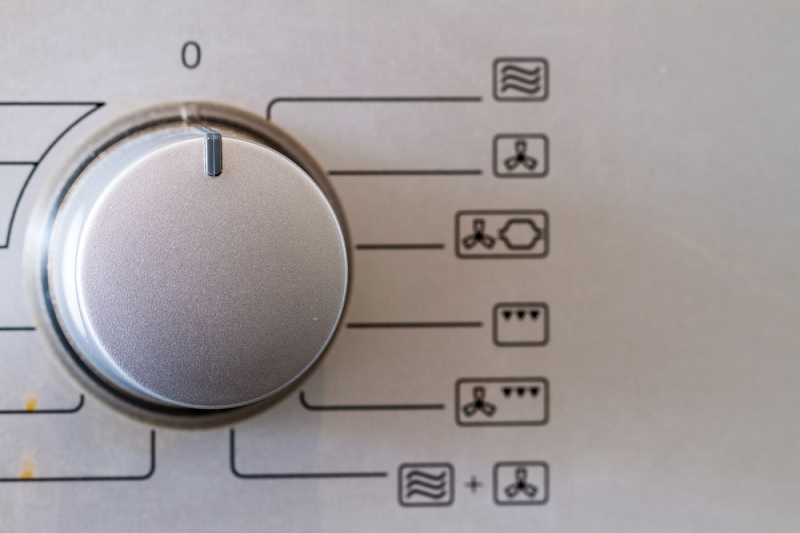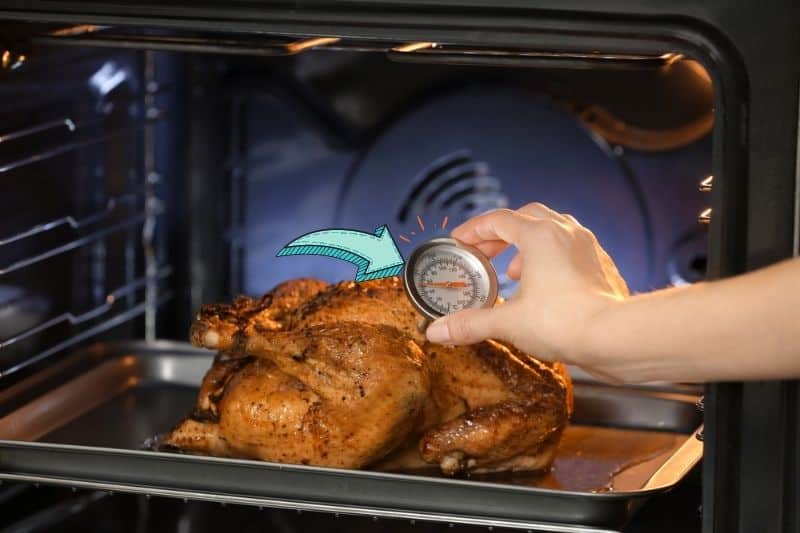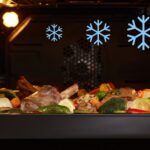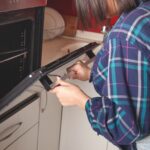Compared to conventional ovens, fan ovens have many advantages. They heat up faster, cook more evenly, and are more energy efficient.
However, when you find your fan oven blowing cold air, it can leave you puzzled and frustrated.
Whether you’re preparing a roast dinner, baking a batch of cookies, or experimenting with a new recipe, a fan oven blowing cold air can ruin your culinary pursuits.
But fear not, as here we explore the potential causes and practical solutions to help you get your trusty kitchen companion back on track.
Why Is My Oven Fan Not Blowing Hot Air?
Fan ovens have a fan that circulates heat around the oven interior, helping to speed up the cooking process.
If you have a fan oven that is blowing cold air, it’s not operating as intended. There could be several reasons for this issue, as explained below:
Reason 1: Incorrect oven setting

One of the most common culprits behind fan ovens blowing cold air is people accidentally using the wrong oven setting.
Some ovens have a “cooling” or “fan-only” setting for cooling the oven after cooking. If your oven is set to this mode, it may blow cold air.
Ensure that your oven is set to the desired temperature and cooking mode. If the settings are correct and the fan is still blowing cold air, it’s likely due to one of the reasons below.
Reason 2: Malfunctioning temperature sensor
Ovens have temperature sensors (also known as thermostats) that help regulate the temperature inside the oven.
They do this by continuously measuring the temperature and feeding this information back to the heating element.
Based on the reading, the heating element will heat up, cool down, or stay the same temperature to maintain a consistent oven temperature.
If the temperature sensor is malfunctioning, it can cause the oven to blow cold air.
This happens because it cannot accurately sense the oven temperature and thinks the oven is getting too warm. It compensates by blowing out cold air instead of hot air.
Reason 3: Defective heating element

Most fan ovens have two heating elements: one at the top of the oven (the broil element) and one at the bottom (the bake element).
These heating elements are responsible for generating heat. If either heating element is faulty, it may not be able to produce heat and warm the oven up.
The fan in your oven doesn’t produce heat; it solely circulates the air heated by the bake and broil elements. If they’re not generating heat, your oven fan will blow cold air.
Reason 4: Safety features
Some fan ovens have safety features that can cause the fan to run when the oven is off.
For instance, if the oven has been used recently, it may continue to run the fan to cool down the internal components.
Once it senses the internal temperature has dropped, the fan should stop.
This is the only reason you don’t need to worry about on this list, as it’s a sign that your oven is working correctly.
You only need to worry if your fan oven is blowing cold air during cooking, which can impact speed and evenness.
In terms of cooling your oven down after use, the fan blowing cool air is a good thing.
How Can I Fix the Fan in My Oven?
If your fan oven is blowing cold air, the problem isn’t actually with the fan. The fan is still functioning and spinning as it should, right?
Therefore, it’s not blowing cold air because it’s broken, it’s blowing cold air because something is wrong with the heating element or thermostat in your oven.
Below is a general guide to help you troubleshoot and potentially fix these issues. Before you start, ensure your fan oven is unplugged or the circuit breaker is turned off to prevent electrical accidents.
Step 1: Measure temperature accuracy

You can determine whether the thermostat in your oven is working by checking whether the temperature is accurate.
To do this, purchase an oven thermometer and follow these steps:
- Turn on the oven and set it to a specific temperature, such as 180°C. Wait for the preheating cycle to complete, which usually takes around five minutes for fan ovens.
- Hang or place an oven thermometer inside the oven on the centre rack. Ensure it’s positioned so you can read it through the oven door without opening it.
- Keep an eye on the oven thermometer as the oven continues to heat up. It should gradually rise to the temperature you set on the oven’s thermostat.
- Once the oven reaches the set temperature, it should maintain a fairly constant temperature. If the thermometer’s reading fluctuates significantly, the thermostat may be malfunctioning.
- For a more comprehensive assessment, test your oven’s thermostat at different temperature settings, such as 120°C, 150°C, and 200°C.
If you suspect a problem, refer to your oven user manual for specific troubleshooting instructions or information on calibrating the thermostat.
Some ovens have a calibration feature that allows you to adjust the thermostat’s setting.
Step 2: Visually inspect the heating elements
If the oven thermostat seems to be in working order, there might be something wrong with the heating elements in your fan oven.
Begin with a visual inspection of the heating elements. Look for any signs of visible damage, such as cracks, breaks, or burn marks.
If you see any damage, the element is likely faulty and needs replacement.
If you can’t spot any visible damage, turn your oven on and inspect the bake and boil elements again. You can do this by following these steps:
- To test the bake element, turn on the oven and set it to bake at a specific temperature, such as 180°C. Allow the oven to preheat before continuing to the next step.
- After the oven has preheated, open the oven door and visually inspect the bake element. It should glow red when it’s on. If it doesn’t glow red, it’s likely defective and needs replacing.
- To test the broil element, turn on the broil function (grill function) of your fan oven to a specific temperature.
- Similar to the bake element, observe the broil element. It should also glow red when activated. If it doesn’t heat up or glow red, it’s likely faulty and should be replaced.
Note: Do not touch the heating elements while your oven is on. They can get extremely hot, and you may end up burning yourself.
Step 3: Measure heating element resistance
If you have a digital multimeter and are comfortable using it, you can perform a more precise test on the heating elements. Here’s how:
- Disconnect the oven from the power source and access the terminals of the heating element. This might involve removing a cover or panel. Consult the manual for guidance if needed.
- Set your multimeter to the resistance setting (ohms, usually represented by the Ω symbol) and place the multimeter probes on the terminals of the heating element.
- A working element should show a resistance reading. Consult your oven’s user manual for the expected resistance range. It can vary depending on the element’s design.
- If the multimeter displays an “open circuit” or an extremely high resistance reading, the element is likely defective and needs to be replaced.
Step 4: Test the thermostat resistance
You can also use a multimeter to carry out more thorough testing of the thermostat in your oven. Turn your fan oven off to avoid electrical accidents, then follow these steps:
- Access the thermostat in your oven and disconnect any wires. If you’re unsure where the thermostat is located, refer to the instruction manual for your oven.
- Set your multimeter to the resistance setting and place its probes onto the thermostat terminals where the wires were connected. It doesn’t matter which probe connects to which terminal. The multimeter should display a resistance reading.
- If the thermostat functions correctly, you should get a reading within a specified resistance range. Consult your oven manual for the expected resistance range
- If the multimeter displays an “open circuit” or a resistance reading significantly outside the expected range, it indicates that the thermostat is likely faulty and should be replaced.
- If the thermostat passes the continuity test, reconnect the wires to the thermostat terminals in their original configuration. If not, contact a technician to replace it with a new one.
Step 5: Contact a professional technician if required
If your oven fan continues to blow cold air and none of the issues are evident or resolvable, you should contact a professional technician for further assistance. They can help you diagnose the problem if you’ve been unable to do so yourself.
Once diagnosed, your technician can also perform necessary repairs or replacements to get your oven functioning correctly. This might involve repairing the heating elements, thermostat, or both.
Top Tip: Be aware that warranties may cover some oven components, so contact the manufacturer for potential warranty service before changing any of the internal parts.

What’s the Benefit of Using the Oven Fan?
Fan ovens have a fan inside to circulate hot air and maintain even temperatures throughout the oven cavity. This is a common feature in many modern ovens used for several purposes.
Compared to conventional ovens, fan ovens can provide:
- More even cooking: The fan helps distribute the heat evenly, ensuring that your delicious homecooked food bakes uniformly. Although the top of the oven is slightly hotter, the cavity is more or less the same temperature throughout.
- Faster cooking: Your oven fan can speed up the cooking process since it circulates heat more thoroughly. The hot air is blown towards the food as the cold air is pushed away, leading to less cooking time. You can also cook food at lower temperatures.
- Better browning: For certain dishes (such as roast dinners or baked goods), the fan can help achieve a desirable level of browning on the surface. This is again due to the quicker cooking time and improved hot air circulation.
- Convection cooking options: Some ovens have a convection cooking mode, which uses a fan to circulate hot air around the oven. Convection cooking is ideal for recipes that benefit from even cooking and browning.
These benefits cannot be achieved if your fan oven is blowing cold air. In fact, it has the opposite effect—it slows cooking time, results in uneven cooking, and prevents food from browning.
For perfectly cooked dishes, you need to fix your oven fan using our solutions listed above.

Hannah is a freelance content writer and self-proclaimed foodie. When Hannah isn’t sitting tapping at her laptop, you’ll probably find her in the kitchen. As an ex-chalet host, she’s used to cooking four-course meals for 10+ people and loves feeding friends and family whenever possible.







